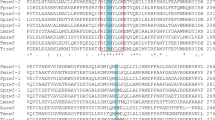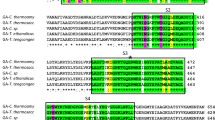Abstract
Glucose-6-phosphate dehydrogenases (G6PDs) are important enzymes widely used in bioassay and biocatalysis. In this study, we reported the cloning, expression, and enzymatic characterization of G6PDs from the thermophilic bacterium Thermoanaerobacter tengcongensis MB4 (TtG6PD). SDS-PAGE showed that purified recombinant enzyme had an apparent subunit molecular weight of 60 kDa. Kinetics assay indicated that TtG6PD preferred NADP+ (k cat/K m = 2618 mM−1 s−1, k cat = 249 s−1, K m = 0.10 ± 0.01 mM) as cofactor, although NAD+ (k cat/K m = 138 mM−1 s−1, k cat = 604 s−1, K m = 4.37 ± 0.56 mM) could also be accepted. The K m values of glucose-6-phosphate were 0.27 ± 0.07 mM and 5.08 ± 0.68 mM with NADP+ and NAD+ as cofactors, respectively. The enzyme displayed its optimum activity at pH 6.8–9.0 for NADP+ and at pH 7.0–8.6 for NAD+ while the optimal temperature was 80 °C for NADP+ and 70 °C for NAD+. This was the first observation that the NADP+-linked optimal temperature of a dual coenzyme-specific G6PD was higher than the NAD+-linked and growth (75 °C) optimal temperature, which suggested G6PD might contribute to the thermal resistance of a bacterium. The potential of TtG6PD to measure the activity of another thermophilic enzyme was demonstrated by the coupled assays for a thermophilic glucokinase.





Similar content being viewed by others
References
Bao QY, Tian YQ, Li W, Xu ZY, Xuan ZY, Hu SN, Dong W, Yang J, Chen YJ, Xue YF, Xu Y, Lai XQ, Huang L, Dong XZ, Ma YH, Ling LJ, Tan HR, Chen RS, Wang J, Yu J, Yang HM (2002) A complete sequence of the T. tengcongensis genome. Genome Res 12(5):689–700
Bradford MM (1976) A rapid and sensitive method for the quantitation of microgram quantities of protein utilizing the principle of protein-dye binding. Anal Biochem 72:248–254
Bruins ME, Janssen AEM, Boom RM (2001) Thermozymes and their applications—a review of recent literature and patents. Appl Biochem Biotech 90(2):155–186
Cheng HR, Jiang N (2006) Extremely rapid extraction of DNA from bacteria and yeasts. Biotechnol Lett 28(1):55–59
Conway T (1992) The Entner-Doudoroff pathway: history, physiology and molecular biology. FEMS Microbiol Rev 9(1):1–27
Cosgrove MS, Naylor C, Paludan S, Adams MJ, Levy HR (1998) On the mechanism of the reaction catalyzed by glucose 6-phosphate dehydrogenase. Biochemistry-US 37(9):2759–2767
Cui Y, Barford JP, Renneberg R (2008) Amperometric trienzyme ATP biosensors based on the coimmobilization of salicylate hydroxylase, glucose-6-phosphate dehydrogenase, and hexokinase. Sensor Actuat B-Chem 132(1):1–4
Hansen T, Schlichting B, Schonheit P (2002) Glucose-6-phosphate dehydrogenase from the hyperthermophilic bacterium Thermotoga maritima: expression of the g6pd gene and characterization of an extremely thermophilic enzyme. FEMS Microbiol Lett 216(2):249–253
Hu W, Zhi L, Zhuo MQ, Zhu QL, Zheng JL, Chen QL, Gong Y, Liu CX (2013) Purification and characterization of glucose 6-phosphate dehydrogenase (G6PD) from grass carp (Ctenopharyngodon idella) and inhibition effects of several metal ions on G6PD activity in vitro. Fish Physiol Biochem 39(3):637–647
Iyer RB, Wang JQ, Bachas LG (2002) Cloning, expression, and characterization of the gsdA gene encoding thermophilic glucose-6-phosphate dehydrogenase from Aquifex aeolicus. Extremophiles 6(4):283–289
Iyer R, Pavlov V, Katakis I, Bachas LG (2003) Amperometric sensing at high temperature with a “wired” thermostable glucose-6-phosphate dehydrogenase from Aquifex aeolicus. Anal Chem 75(15):3898–3901
Kelley LA, Sternberg MJ (2009) Protein structure prediction on the Web: a case study using the Phyre server. Nat Protoc 4(3):363–371
Kusumoto M, Kishimoto T, Nishiya Y (2010) Improvement of thermal stability of Leuconostoc pseudomesenteroides glucose-6-phosphate dehydrogenase. J Anal Bio-Sci 33(4):397–400
Larkin MA, Blackshields G, Brown NP, Chenna R, McGettigan PA, McWilliam H, Valentin F, Wallace IM, Wilm A, Lopez R, Thompson JD, Gibson TJ, Higgins DG (2007) Clustal W and Clustal X version 2.0. Bioinformatics 23(21):2947–2948
Lee WH, Kim MD, Jin YS, Seo JH (2013) Engineering of NADPH regenerators in Escherichia coli for enhanced biotransformation. Appl Microbiol Biotechnol 97(7):2761–2772
Levy HR (1979) Glucose-6-phosphate dehydrogenases. Adv Enzymol Relat Areas Mol Biol 48:97–192
Levy HR (1989) Glucose-6-phosphate-dehydrogenase from Leuconostoc mesenteroides. Biochem Soc T 17(2):313–315
McCarthy JK, O’Brien CE, Eveleigh DE (2003) Thermostable continuous coupled assay for measuring glucose using glucokinase and glucose-6-phosphate dehydrogenase from the marine hyperthermophile Thermotoga maritima. Anal Biochem 318(2):196–203
Naylor CE, Gover S, Basak AK, Cosgrove MS, Levy HR, Adams MJ (2001) NADP(+) and NAD(+) binding to the dual coenzyme specific enzyme Leuconostoc mesenteroides glucose 6-phosphate dehydrogenase: different interdomain hinge angles are seen in different binary and ternary complexes. Acta Crystallogr D 57:635–648
Olive C, Levy HR (1971) Glucose 6-phosphate dehydrogenase from Leuconostoc mesenteroides—physical studies. J Biol Chem 246(7):2043–2046
Olive C, Geroch ME, Levy HR (1971) Glucose 6-phosphate dehydrogenase from Leuconostoc mesenteroides—kinetic studies. J Biol Chem 246(7):2047–2057
Purich DL (2010) Enzyme kinetics: catalysis and control: a reference of theory and best-practice methods. Elsevier, Amsterdam
Rowland P, Basak AK, Gover S, Levy HR, Adams MJ (1994) The three-dimensional structure of glucose 6-phosphate dehydrogenase from Leuconostoc mesenteroides refined at 2.0 A resolution. Structure 2(11):1073–1087
Srivastava PK, Singh S (2013) Immobilization and applications of glucose-6-phosphate dehydrogenase: a review. Prep Biochem Biotechnol 43(4):376–384
Stanton RC (2012) Glucose-6-phosphate dehydrogenase, NADPH, and cell survival. IUBMB Life 64(5):362–369
Stover NA, Dixon TA, Cavalcanti AR (2011) Multiple independent fusions of glucose-6-phosphate dehydrogenase with enzymes in the pentose phosphate pathway. PLoS One 6(8):e22269
Uppada V, Bhaduri S, Noronha SB (2014) Cofactor regeneration—an important aspect of biocatalysis. Curr Sci India 106(7):946–957
Verma A, Suthar MK, Doharey PK, Gupta S, Yadav S, Chauhan PMS, Saxena JK (2013) Molecular cloning and characterization of glucose-6-phosphate dehydrogenase from Brugia malayi. Parasitology 140(7):897–906
Wang J, Xue Y, Feng X, Li X, Wang H, Li W, Zhao C, Cheng X, Ma Y, Zhou P, Yin J, Bhatnagar A, Wang R, Liu S (2004) An analysis of the proteomic profile for Thermoanaerobacter tengcongensis under optimal culture conditions. Proteomics 4(1):136–150
Xue YF, Xu Y, Liu Y, Ma YH, Zhou PJ (2001) Thermoanaerobacter tengcongensis sp nov., a novel anaerobic, saccharolytic, thermophilic bacterium isolated from a hot spring in Tengcong, China. Int J Syst Evol Microbiol 51:1335–1341
Ying W (2008) NAD+/NADH and NADP+/NADPH in cellular functions and cell death: regulation and biological consequences. Antioxid Redox Signal 10(2):179–206
Acknowledgments
This work was supported by TMO Renewables Limited and Ministry of Science and Technology of China (Grant 2013CB734001).
Author information
Authors and Affiliations
Corresponding authors
Additional information
Communicated by F. Robb.
Rights and permissions
About this article
Cite this article
Li, Z., Jiang, N., Yang, K. et al. Cloning, expression, and characterization of a thermostable glucose-6-phosphate dehydrogenase from Thermoanaerobacter tengcongensis . Extremophiles 20, 149–156 (2016). https://doi.org/10.1007/s00792-016-0808-z
Received:
Accepted:
Published:
Issue Date:
DOI: https://doi.org/10.1007/s00792-016-0808-z




